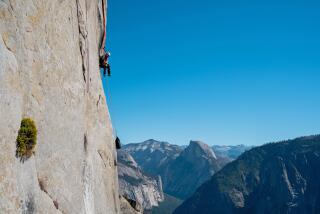Breast Cancer Survivors Scale New Heights--to Increase Awareness : Health: Expedition that scaled Western Hemisphere’s highest peak helps to raise funds for research. Renewed passion for life spurred the women.
- Share via
In her mid-40s, Sandy Eiler was shadowed by the nagging suspicion that something was wrong with her. She was haunted by an inexplicable sense of impending doom.
In 1989, her fears were realized; she was diagnosed with breast cancer.
“I was facing a tremendous mountain,” she recalls.
Eiler, a 52-year-old former nurse and mother of seven from Ann Arbor, Mich., climbed that mountain with alacrity. A mastectomy, massive reconstruction and six months of chemotherapy later, she forged ahead with her life. She owns a public relations firm and works out regularly.
But there was another mountain to climb, this one of her own choosing. This winter, she joined Expedition Inspiration, a trek up 23,000-foot Mt. Aconcagua in Argentina--the highest peak in the Western Hemisphere--to raise awareness about breast cancer and funds for research.
Twenty-five people, including 17 breast cancer survivors, joined the expedition, coordinated by the Breast Cancer Fund of San Francisco. And they were successful: Three climbers reached the summit on Feb. 4.
“A disease is like a mountain in anyone’s life; it’s an enormous hurdle,” Eiler said in a telephone interview.
Underwritten by Jansport Inc., the campaign aims at raising $2.3 million for breast cancer research and treatment. So far, $1 million has been donated at luncheons, cocktail parties and other events, said Eiler.
The professional and personal backgrounds and physical capabilities of the expedition members varied. The thing they had in common was their past medical turmoil. Some were diagnosed as recently as a year ago; others are 20-year survivors. But, inherently, they have a renewed passion for life.
“Women should reclaim their lives. Breast cancer has already taken too much of my life,” said Roberta Rama, 35, of San Mateo, Calif., a Merrill Lynch administrative assistant who was diagnosed when she was 23.
While the cancer has been excised from their bodies, many of these women are haunted by painful memories of their diagnoses, operations and frustrations dealing with medical bureaucracy.
“When you’re diagnosed it’s a very lonely experience. If we have to climb a 23,000-foot mountain to raise awareness, so be it,” said Eiler.
The money raised will provide grants for research and to fund outreach programs and psychosocial support programs for patients and their families, said Andrea Martin, executive director of the Breast Cancer Fund.
“Our motive is to eliminate breast cancer before our daughters have to deal with it,” said Martin, 48, of Sausalito, Calif.
In 1987, two weeks after losing her sister-in-law to breast cancer, Martin was diagnosed. After a mastectomy, several rounds of radiation and living cancer-free for a couple of years, she discovered a lump on her healthy breast. Again, she underwent aggressive forms of treatment.
“The first time I was scared. But the second time I was angry. Nobody was answering questions and money was needed for treatment and education,” said Martin.
The symbolism of mountains and the concept of raising awareness and money by trekking to challenging summits appeals to the 5-foot, 105-pound Martin.
Climbing also may be therapeutic. A 10-year study by Leslie Bernstein at the University of Southern California supports the theory that physical exercise lowers the risk of breast cancer.
Fashion designer and writer Laura Evans, 48, of Sun Valley, Idaho, is a breast cancer survivor who spearheaded the expedition. She had already climbed 14,000-foot Mt. Rainier in Washington, 20,000-foot Huayna Potosi in Bolivia and 18,500-foot Mt. Elbrus in Russia.
She was once told she had a 15% chance of long-term survival; she endured a lumpectomy and bone marrow transplant. To her, there are profound parallels between surviving a disease and climbing a mountain.
“You have to take one small step at a time. You have fears as you come face to face with death,” she said. “And surviving calls for a strong support group.”
For Evans and her teammates, high winds, steep inclines and rugged conditions were worth enduring to get one message across: There is life after breast cancer.
“When you hear you have cancer you think you will die,” Evans said. “It takes time to feel you can move on with your life.”
The summit team carried 170 Tibetan prayer flags with the names of breast cancer victims, patients and survivors printed on them.
More to Read
Sign up for Essential California
The most important California stories and recommendations in your inbox every morning.
You may occasionally receive promotional content from the Los Angeles Times.













